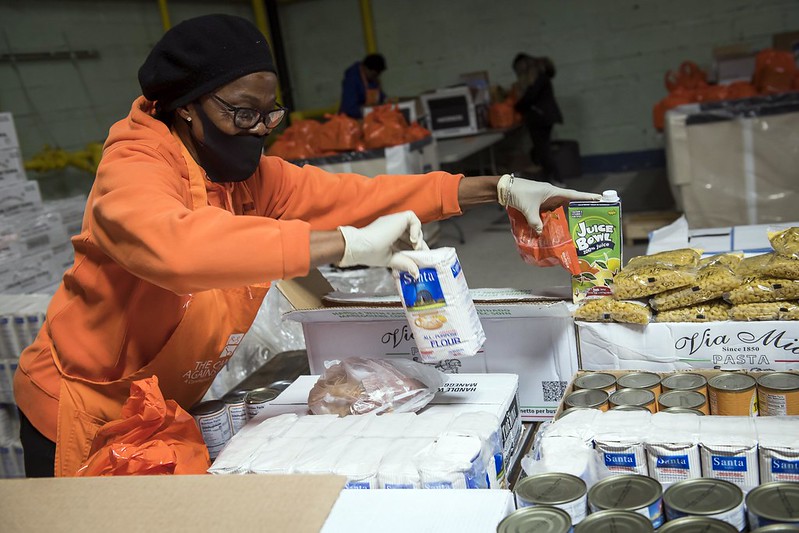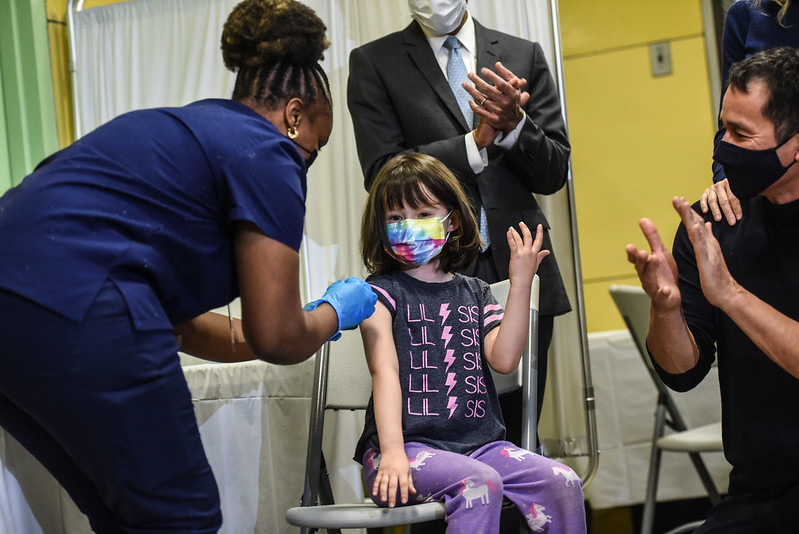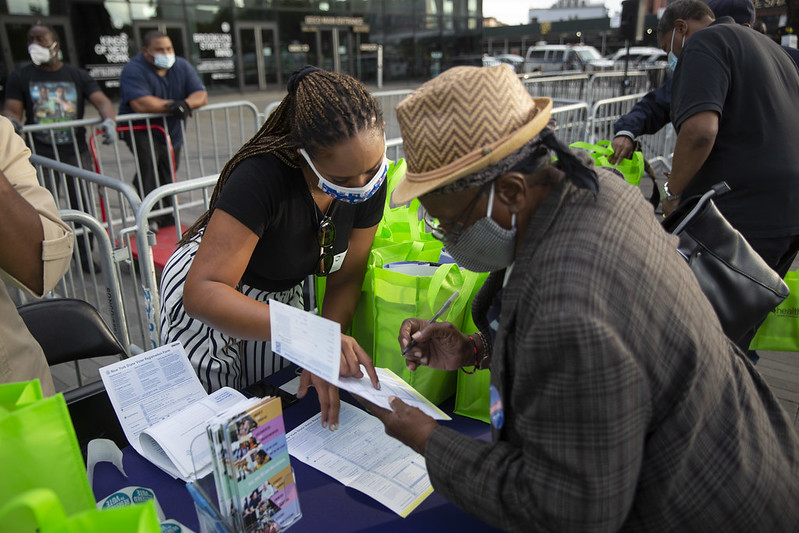White House Hunger Summit Must Get Real About Poverty to be Successful

Emergency food (photo: Ed Reed/Mayoral Photography Office)
The White House will soon convene a conference on hunger, nutrition and health – the first of its kind in over five decades. In that time we have made great strides in reducing food insecurity, but the changes are not all good. After an explosion of unhealthy, cheap foods, diet-related diseases such as diabetes, obesity, and hypertension have become some of the leading causes of death. The goal of this conference is therefore not only to end food insecurity but to increase healthy eating and physical activity to save lives.
This conference has five pillars, all necessary to help create a complete picture of health. But the first pillar – access and affordability – holds the key to achieving the success of the other pillars.
I have spent much of my career in nutrition and research and appreciate the need to integrate four other pillars to combat diet-related diseases with access, physical activity, education, and research. But if we acknowledge the true extent of poverty in America, then the anchor pillar, food access and affordability, must be well-funded.
Food insecurity is about poverty. It’s about not having money to buy food after you’ve paid your rent, electricity, a metro card, gas, or your medicine co-pay. It’s about not having places to buy fresh food in your neighborhood, or the money to buy fresh food when it is available.
Poverty is political. More realistic thresholds would reveal the true extent of poverty in the United States. And even with the too-low thresholds we use today, poverty at 11% (which some people would applaud as it is at its lowest) is not good enough. We can do better, and we have.
During the last two years – when we increased the child tax credits, offered free meals in school for all, reduced arduous paperwork to apply for help, opened avenues for non-citizens to receive support – poverty rates, particularly among children, decreased even more. We should institute these changes permanently.
We should also look at poverty numbers without fear, creating more realistic thresholds, supporting more people to grow up healthy.
The poverty threshold is calculated annually by the U.S. Census Bureau as the amount of money required for a family or individual to meet basic needs. There are no regional differences. The U.S. Department of Health and Human Services then uses the results to set guidelines for eligibility for federal programs such as food assistance. The guidelines are the same for 48 states (Hawaii and Alaska are the exceptions because they are not mainland).
The poverty threshold uses an archaic equation that was created in the mid 1960s and is simply the cost of a minimum food diet multiplied by three to account for other expenses. It is updated annually for consumer price changes, but the same antiquated equation is maintained. There is a newer model called the supplemental poverty measure that includes noncash benefits as well as housing and other costs but this is not used universally. The fact that the basic equation is simply the cost of a minimal food diet is also concerning if we are hoping to increase health as well as reduce hunger. Fresh food costs more. Minimal won’t do.
We must vary the threshold to accommodate those who live in more expensive cities, and those whose incomes are subject to different minimum wage laws. It is unfathomable that someone who lives in a rural area and someone who lives in New York City, for example, receive the same benefit.
A woman with one child in 2022, for example, is considered poor if she makes less than the poverty threshold of $18,310. The guidelines then allocate benefits based on a percentage over the threshold. Using New York City as an example, where the minimum wage is $15 an hour, if that woman worked full-time, and depending on deductions, she would either be ineligible for SNAP (food stamps) or receive a paltry $23. Here is a person who lives in a city where the cost of living is very high, and she is doing exactly what the government wants her to do, yet she cannot even get adequate help to buy healthy food. If eating healthy is vital to being healthy, then the SNAP allocation should reflect that. It might, if the poverty thresholds varied.
We have the power and the tools to end hunger and food insecurity in the United States. Now we need the will. I’m excited for this White House conference. I’m excited that the government is serious about helping everyone eat healthy and be healthy. Let’s finally make healthy food available and affordable for everyone in the United States and watch as the other four pillars begin to take root and bear fruit.
***
Cathy Nonas is the CEO of Meals for Good, former Senior Advisor in the Center for Health Equity at the New York City Department of Health and Mental Hygiene and an NYU McSilver Fellow-in-Residence. On Twitter @mealsforgood.
***
Have an op-ed idea or submission for Gotham Gazette? Email This email address is being protected from spambots. You need JavaScript enabled to view it.
Keeping Kids, Families, and Communities Safe as Children are Back to School

Getting vaxxed (photo: Michael Appleton/Mayoral Photography Office)
Back-to-school is traditionally an exciting time for parents, teachers, and educators. With New York City returning to school this month after COVID-19 kept children isolated from classmates and, in many instances, interrupted routine medical visits, experts fear the population will have lower immunity and be behind on routine vaccines.
The city continues to work its way out of the pandemic and encourage "back-to-school checkups." Let's ensure the whole family is up to date with their vaccinations and healthcare needs.
If your child has not had a checkup in the past year, you should schedule an appointment with your pediatrician. We not only ensure that the child is up to date on immunizations but also evaluate growth and development, nutritional status, and behavioral, developmental, and psychosocial issues that may impact school performance. Schools and public health officials are reminding parents to get their kids caught up on recommended childhood vaccinations or risk the genuine threat of the return of illnesses once mostly eliminated.
Since the Pandemic, vaccination rates have plummeted and not yet rebounded, leaving school-age children vulnerable. During the 2020-2021 school year, vaccination coverage decreased by one percentage point for U.S. kindergarteners compared to the prior school year, the CDC found, and infant vaccination rates also dropped between 2019 to 2020.
New Yorkers remember that in 2019 there was a measles outbreak in Brooklyn, and we’re seeing the case numbers rise around the country and worldwide; we are seeing the return of this and other diseases once thought eradicated. Worldwide measles cases increased 79% for the first two months of 2022 compared to 2021. Additionally, New York State health officials confirmed the first case of polio in the U.S. in almost a decade in Rockland County and another in New York City.
Pandemic restrictions and virtual education reduced kids' risk of contracting measles, mumps, rubella, and other communicable diseases, and masking, testing, and contact-tracing helped keep covid and other illnesses from spreading through classrooms at higher rates. However, the arrival of the more infectious Omicron subvariant underscored how quickly things could change significantly since schools can be breeding grounds for community spread. For example, in March, Los Angeles Schools saw a spring flu outbreak that resulted in school administrators closing school for in-person attendance.
Covid vaccination rates lag in teenagers and children. Unfortunately, we are now contending with more vaccine hesitancy. Vaccinations are more crucial than ever, especially as we see polio detections. A Kaiser Family Foundation survey found that more than four in ten parents will not vaccinate their children under five years old against the COVID-19 virus. However, to protect against measles, 95% or higher herd immunity is necessary, and if vaccination rates dip, especially in local communities or schools, outbreaks are possible.
When our schools start to return to normalcy, our city cannot handle a massive polio outbreak that could disrupt our children's education. However, according to a CDC analysis, vaccination coverage against measles for kindergarteners nationwide in the 2020-2021 school year was 93.9%. Public rates show that almost 14% of young New York City children haven't received a polio vaccination. To protect our schools and our children, parents must ensure their kids are vaccinated.
We all want a "normal" school year after the last two-plus years of living in a pandemic, but we need everyone to do their part. That's why we urge families to remember to vaccinate their children to keep them and their families safe from outbreaks. It will take all of us working together to make this school year magical.
***
Dr. Andrea Perry, MD, MBA Pediatrician, is Medical Director at EmblemHealth. On Twitter @EmblemHealth.
***
Have an op-ed idea or submission for Gotham Gazette? Email This email address is being protected from spambots. You need JavaScript enabled to view it.
Worried About the 2022 Election? 3 Ways to Get Organized and Make Change

Organizing New Yorkers (photo: John McCarten/City Council)
It’s fall in New York, which means pumpkin spice lattes when it’s still too hot, our football teams are terrible, and election season is essentially over. Well, let’s take a beat on that last one for a second. While it may be true that most of our races are decided in the Democratic primary, there’s a lot at stake in 2022 – from who occupies the Governor’s Mansion to what we value as a state.
Candidates aren’t the only thing on the ballot this year. Who you vote for will decide whether hard-fought criminal justice reforms will be rolled back (further), whether the legalization of marijuana will be truly equitable, and so much more. Many might not realize that $4 billion is sitting on the back of their ballots, potential environmental funding that could go to improving over-polluted Black, Latino, and Asian neighborhoods.
So, what’s the plan? That’s the $220 billion question (and the size of the state budget). The proven plan of action to make sure New York State crosses the threshold of change is to organize. Communities of color have a powerful vote we must make sure is exercised during one of the most important November elections this state has seen in decades.
Here are three things you can do this fall to make change happen in your neighborhood and beyond:
First, get off social media and talk to your neighbors. Figure out what issues are important to them. If you live in Southeast Queens, you might be surprised by how many people want property tax reforms, which is one place the state races come in. Your neighbors in public housing may have been fighting to repair a senior center, which every level of government bears responsibility for (and don’t let officials tell you otherwise). Read up on the back-of-the-ballot measures and be ready to spread the word — most people don’t realize they have a say on these major policy decisions.
Second, find the people who are running and push them to make real commitments on issues of importance that you organize around. The key here is to make sure they hear the same message over and over and over again. It’s essential that your community speaks as one voice, which I know is easier said than done considering even the friendliest of neighbors have their differences.
As an organizer I’ve found the best path is to focus on what unites us – the change that can positively impact the most people – while also acknowledging and validating those differences. Find your local civic organizations, faith leaders, and other recognizable community members who can bring everyone together, especially by speaking publicly on these issues.
Third, above all else, go vote. I don’t want to hear that it’s November, it’s chilly, you had a bad day at work, or it’s dark early. In New York, you can still vote by mail due to the pandemic. There are also nine days of early voting. Your Election Day poll site is likely on your way to or home from work (and not that far from home if you work from home). There’s no excuse not to vote anymore. Cynics be damned: change starts at the ballot box the more people vote. In fact, challenge two friends to go vote and make sure they each get two more people to go. The only way to show the power of a community is with that all-too-powerful right to vote.
These steps might seem overly simple, but sadly they’re too often forgotten. We take this kind of work for granted, only to complain when our leaders fail us or there isn’t any accountability for matters like racial injustice. It’s what lost elections and influenced how districts are drawn up. This fall let’s get back to basics, back to engaging our neighbors, and back to the polls.
***
Paul Persaud is a Vice President at Actum, a global consulting firm, where he specializes in third-party organizing. On Twitter @Actum.
***
Have an op-ed idea or submission for Gotham Gazette? Email This email address is being protected from spambots. You need JavaScript enabled to view it.




